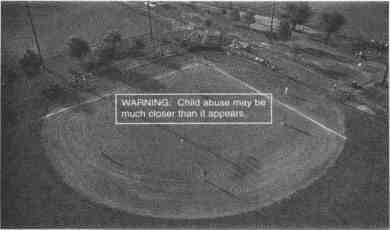
There may be a lot more going on between these lines than just baseball.' Image and caption from NIYSA's advertisement for Child Abuse and Youth Sports: A Comprehensive Risk Management Program. See ad on the bock Inside cover in this issue of IP&R.
FEATURE ARTICLE
NIYSCA provides risk management to prevent abuse
BY GREG BACH
|
|
There may be a lot more going on between these lines than just baseball.' Image and caption from NIYSA's advertisement for Child Abuse and Youth Sports: A Comprehensive Risk Management Program. See ad on the bock Inside cover in this issue of IP&R. |
Children nationwide suffer the horrors of abuse and neglect every day. It happens at home, school and—with alarming frequency—in organized sports.
In fact, a study by the Minnesota Amateur Sports Commission found that 45.3 percent of the children surveyed said they had been called names, yelled at and insulted while playing sports while 17.5 percent reported that they had been hit, kicked and slapped and 21.5 percent said they had been pressured to play with an injury. Furthermore, 8 percent said they have been called names with sexual connotations and 3.4 percent reported that they had been pressured into sex or sexual touching.
These frightening figures indicate that individuals and organizations that cater to young athletes must have the prevention and elimination of child abuse as their top priority.
Most leaders of youth sports programs and organizations are certainly not immune from these problems, but they now have a place to turn for help through the National Institute For Youth Sports Administration (NIYSA).
The NIYSA, a division of the nonprofit National Alliance For Youth Sports, has developed "Child Abuse and Youth Sports: A Comprehensive Risk Management Program." This innovative program provides important information on the screening, training and evaluation of staff, policies and procedures on responding to abuse, how to safeguard organizations and participants, developing codes of conduct and how to stop problems before they begin, among many other important areas.
It was developed from the Alliance's "National Summit On Child Protection In Youth Sports," which brought together some of the country's top experts on the subject for two days of intense discussion.
"Youth sports must be conducted free from all forms of abuse so young athletes gain the positive benefits sports participation for children is meant to provide," said Lisa Licata, director of the NIYSA.
"Communities and organizations have a legal responsibility to eliminate abuse from their programs. The Child Abuse and Youth Sports Program assists organizations by providing resources and knowledge to comprehensively educate administrators, parents, coaches and young athletes."
A comprehensive program that addresses child abuse is necessary because every organization has a responsibility to provide safe sports experiences for every youngster
January/February 1997 /15
Child abuse in sports is any action taken by an adult which results in the direct or indirect physical and/or emotional harm of children.
The three types of abuse that occur in youth sports are emotional, physical and sexual.
• Emotional abuse is behavior that attacks a child's emotional development and sense of self-worth. Examples include constant criticizing, belittling, insulting, rejection and providing no love, guidance or support.
• Physical abuse is non-accidental physical injury which includes slapping, grabbing, shoving or hitting a child as well as using excessive forms of exercise as punishment and depriving athletes of water.
• Sexual abuse is any form of sexual contact or implied sexual contact between an adult and a child.
"I applaud the NIYSA for their outstanding efforts to promote healthy interaction between youth sports organizations and the children who participate in sports activities," said Joy Byers, director of communications for the National Committee to Prevent Child Abuse (NCPCA). "What could be more important than focusing on strategies that will protect children from harm?"
Often, the most difficult step is convincing people that implementing a child abuse program is worth the effort but an instance of abuse is much more expensive than a commitment of time and energy. Effective youth sports risk management includes protection, promotion and prevention and covers everything from awareness and screening policies to promoting the positive benefits of sports participation.
In a national survey recently conducted by the National Committee to Prevent Child Abuse (NCPCA) nearly one million children were confirmed as victims of maltreatment in 1995 and more than three million were reported as victims of child abuse and neglect.
"All kids deserve a positive sports experience free from all forms of abuse," said Atlanta Braves second baseman Mark Lemke, the NIYSAs national spokesperson on child abuse prevention.
"When it comes to youth sports kids just want to play and have fun." •

GREG BACH
is the director of public relations tor the National Alliance for Youth Sports. For more
information, contact NIYSA at 205O Vista Parkway, West Palm Beach, Florida
33411, 800.729.20.57 M-free;, 56I.684.141 [phone], 561.684.2546
thxl, http://www.nays.org.
The IPRA office has several child abuse and youth sport kits available for purchase. Call IPRA executive director Kay Forest at 630.752.0141.
16/ Illinois Parks and Recreation
|
Sam S. Manivong, Illinois Periodicals Online Coordinator Illinois Periodicals Online (IPO) is a digital imaging project at the Northern Illinois University Libraries funded by the Illinois State Library |